
Simeon Borisov Saxe-Coburg-Gotha is a Bulgarian politician who reigned as the last tsar of the Kingdom of Bulgaria as Simeon II from 1943 until 1946. He was six years old when his father Boris III of Bulgaria died in 1943. Royal power was exercised on his behalf by a regency council led by Simeon's uncle Kiril, Prince of Preslav, General Nikola Mihov and prime minister, Bogdan Filov. In 1946 the monarchy was abolished by referendum, and Simeon was forced into exile.

Avial NV, LLC was an airline based in Moscow, Russia. It operated charter, passenger, and cargo flights. Its main base was Domodedovo International Airport, Moscow. Operations were suspended in 2010 with debts of over 1 million roubles and operations were banned after the expiration of the license in July 2011.
A mad scene is an enactment of insanity in an opera or play. Many are very dramatic, representing a virtuoso piece for singers; some were written with a specific singer in mind. Most have been composed for soprano voice, but other examples exist.

Hericium erinaceus, commonly known as the lion's mane mushroom, yamabushitake, bearded tooth fungus, bearded hedgehog, or old man's beard, is an edible mushroom belonging to the tooth fungus group. Native to North America, Europe, and Asia, it can be identified by its long spines, occurrence on hardwoods, and tendency to grow a single clump of dangling spines. The fruit bodies can be harvested for culinary use.
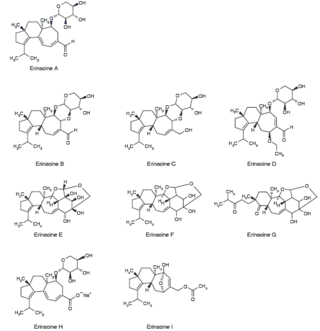
Erinacines are natural substances isolated from Hericium erinaceus. They belong to the group of cyathin diterpenoids and are subjects of pharmacological research.

The Hericiaceae are a family of fungi in the order Russulales. The best known genus is Hericium, species of which are valued for their medicinal properties in Oriental medicine. Taxa are mainly known from north temperate regions, and are saprobic on rotting wood. Phylogenetic analysis suggests that Hericiaceae belongs to the russuloid clade of homobasidiomycetes, and morphological and molecular evidence links it with the families Auriscalpiaceae, Bondarzewiaceae and Echinodontiaceae. Originally proposed in 1961 by Taisiya Lvovna Nikolayeva as a subfamily of Hydnaceae, Hericiaceae was formally published as a family by Marinus Anton Donk in 1964.

Anthem of His Majesty the Tsar or God Save the Tsar was the royal anthem of the Kingdom of Bulgaria from 1908 to 1944. The original music was written by Emil von Sauer. Later the composition by Emanuil Manolov was adopted, and the lyrics were written by Major General Georgi Agura. During this period, the national anthem of the Kingdom of Bulgaria was Shumi Maritsa and the "Anthem of His Majesty the Tsar" was played immediately after it on every solemn occasion in the Tsar's presence.
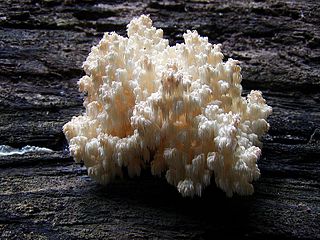
Hericium is a genus of edible mushrooms in the family Hericiaceae. Species in this genus are white and fleshy and grow on dead or dying wood; fruiting bodies resemble a mass of fragile icicle-like spines that are suspended from either a branched supporting framework or from a tough, unbranched cushion of tissue. This distinctive structure has earned Hericium species a variety of common names—monkey's head, lion's mane, and bear's head are examples. Taxonomically, this genus was previously placed within the order Aphyllophorales, but recent molecular studies now place it in the Russulales.

Krylos is a small village of Ivano-Frankivsk Raion in Ivano-Frankivsk Oblast, Ukraine. It is located 5 kilometres south of modern Halych and is part of the National preserve Ancient Halych. The village covers an area of 19.18 square kilometres. The village council consists of 16 people. Krylos belongs to Halych urban hromada, one of the hromadas of Ukraine.

The hydnoid fungi are a group of fungi in the Basidiomycota with basidiocarps producing spores on pendant, tooth-like or spine-like projections. They are colloquially called tooth fungi. Originally such fungi were referred to the genus Hydnum, but it is now known that not all hydnoid species are closely related.
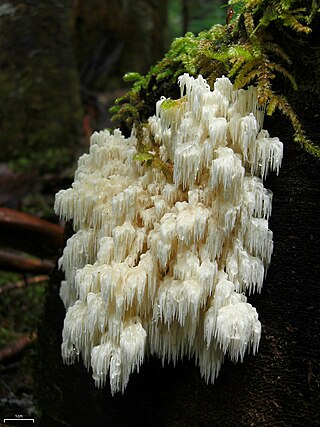
Hericium abietis, commonly known as the bear's head, conifer coral hericium, or western coral hedgehog, is an edible mushroom in the tooth fungus group. It grows on conifer stumps or logs in North America, producing a cream white fruit body up to 10–75 cm (4–30 in) tall and wide. It fruits from after the start of the fall rains to mid-season.
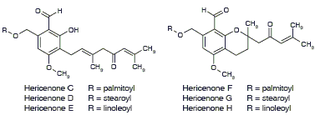
Hericenones is a class of benzaldehydes that are isolates of the fruiting body of Hericium erinaceum that promote nerve growth factor synthesis in vitro.
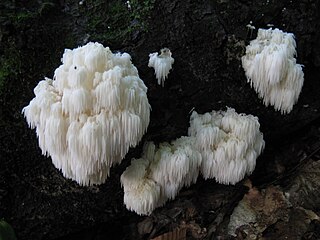
Hericium americanum, commonly known as the bear's head tooth fungus is an edible mushroom in the tooth fungus group. It was described as new to science in 1984 by Canadian mycologist James Herbert Ginns.
The appeal to the State Duma of Russia to charge Vladimir Putin with treason is an initiative of council deputies of the Smolnynske municipal entity in Saint Petersburg and the Lomonosov municipal district of Moscow, on September 8, 2022, which called for the head of the Kremlin, Vladimir Putin, to be charged with treason. The next day, seven deputies were called to the police.
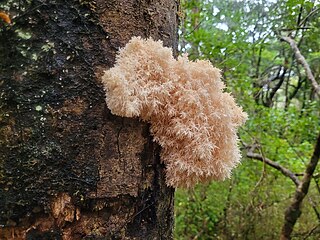
HerIcium novae-zealandiae is a species of fungus in the Hericiaceae family. Formerly classified as Hericium coralloides which shares an almost identical morphology. Being saprotrophic, H. novae-zealandiae can be observed growing from dead, decaying wood. Also known as pekepekekiore, it is endemic to New Zealand and was consumed by indigenous Māori.
Hericium rajchenbergii is a species of fungus in the family Hericiaceae native to Argentina, first described by Gerardo Robledo & Nils Hallenberg in 2012. It grows on dead stems of Lithraea molleoides in the forests of Chaco Serrano. The fruitbodies resemble those of Hericium coralloides, and H. rajchenbergii can be recognized from them by different substrate and slightly bigger spores.

Hericium flagellum is a species of fungus in the family Hericiaceae native to Europe, first described by Giovanni Antonio Scopoli, and placed into its current genus by Christiaan Hendrik Persoon in 1797. It was confirmed—using sexual incompatibility studies—to be a distinct species from H. coralloides in 1983. Found in montane areas, typically on newly fallen trunks and stumps of fir, especially silver fir with one study finding over half of recorded specimens growing on silver fir deadwood in high conservation value areas. Spores are 5–6.5 by 4.5–5.5 µm.
Hericium rajendrae is a species of edible fungus in the family Hericiaceae native to the Himalayas, first described by Upendra Singh and Kanad Das in 2019. It can be distinguished from other Hericium growing in India by reddish white to pale red coloured fruiting bodies. It is collected and eaten by the local population, and called by them Lal guchha chyun in Garhwali language.
Hericium bharengense is a species of fungus in the family Hericiaceae native to Sikkim in India, first described by K. Das, JA Stalpers & Ursula Ebelhardt in 2011. It can be distinguished from related species by "intricate" branching pattern of hymenophores, moderately long spines, size and ornamentation pattern of fruit bodies.
Hericium fimbriatum is a species of fungus in the family Hericiaceae native to Pennsylvania, USA, first described by Howard James Banker in 1906. It has long teeth (6–8 mm) and fusiform cystidia that protrude through the hymenium. Its basidiospores are 4.3-5.5 × 1.5-2 μm big, and together with other microscopic features resemble those of Mycoacia aurea.













